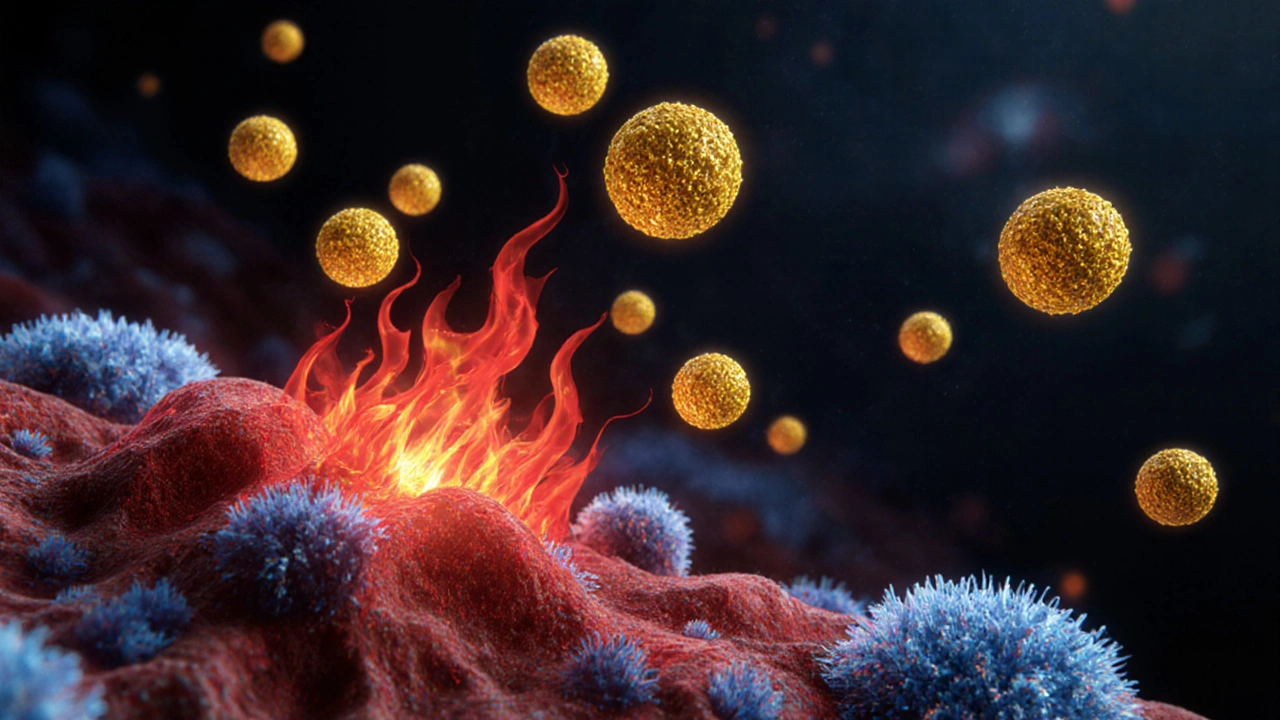
Turmeric Absorption Calculator
Discover how much of turmeric's anti-inflammatory benefits you're actually getting. Without the right combinations, less than 1% of curcumin is absorbed by your body. With black pepper and fat, absorption can increase by up to 2,000%.
Your turmeric absorption will be:
With black pepper and fat, you get the most effective anti-inflammatory benefits. Without them, most of the turmeric is wasted.
There’s a simple kitchen spice that doctors, scientists, and traditional healers across the world agree is one of the most powerful weapons against chronic inflammation. It’s not a pill. It’s not a fancy supplement. It’s turmeric.
If you’ve ever felt stiff joints in the morning, had swelling in your knees, or noticed your body just feels heavier than it should, you’re dealing with inflammation. Not the kind that comes from a cut or a sprain-that’s helpful. This is the silent, slow-burning kind that creeps in over years and leads to arthritis, heart disease, diabetes, and even brain fog. And the best part? You can fight it with something you already have in your cupboard.
Turmeric Isn’t Just a Spice-It’s a Medicine
Turmeric comes from the root of the Curcuma longa plant. It’s been used in Ayurveda for over 4,000 years to treat pain, digestive issues, and skin conditions. But modern science has caught up. In 2017, a review of 15 clinical trials published in the Journal of Medicinal Food found that curcumin, the main active compound in turmeric, was as effective as ibuprofen at reducing pain and swelling in people with osteoarthritis-with zero side effects.
Curcumin works by blocking NF-kB, a molecule that turns on inflammation genes in your cells. Think of it like flipping a switch. When your body is injured or stressed, NF-kB screams, “Start the fire!” Curcumin steps in and quietly turns that switch off. No guesswork. No guesswork needed.
Why Turmeric Beats Other Anti-Inflammatory Foods
You’ve probably heard about ginger, garlic, blueberries, or omega-3s being anti-inflammatory. They all help. But none come close to turmeric’s power. Here’s how they stack up:
| Food/Supplement | Active Compound | Proven Inflammation Reduction | Daily Dose Needed |
|---|---|---|---|
| Turmeric (curcumin) | Curcumin | High (70-80% reduction in markers in trials) | 500-1,000 mg |
| Ginger | Gingerol | Moderate (30-40% reduction) | 1-2 grams fresh |
| Omega-3 (fish oil) | EPA/DHA | Moderate (25-50% reduction) | 2,000-3,000 mg |
| Blueberries | Anthocyanins | Low to moderate (10-20% reduction) | 1 cup daily |
| Green tea | EGCG | Low (15-25% reduction) | 3-5 cups daily |
Turmeric doesn’t just reduce inflammation-it reverses it. In a 2021 study from the University of California, people with rheumatoid arthritis who took 500 mg of curcumin daily for 8 weeks saw a 58% drop in C-reactive protein, a key inflammation marker. That’s more than what most NSAIDs achieve.

Here’s the Catch: Turmeric Alone Doesn’t Work
Here’s where most people fail. Just sprinkling turmeric on your rice won’t do much. Curcumin is poorly absorbed by your body. Less than 1% of what you eat actually gets into your bloodstream. That’s why traditional Indian cooking always pairs turmeric with black pepper and fat.
Black pepper contains piperine, which boosts curcumin absorption by up to 2,000%. A pinch of pepper turns a weak effect into a strong one. And fat? Curcumin is fat-soluble. It needs oil to dissolve and get absorbed. That’s why golden milk-turmeric, black pepper, and coconut milk-is more than a trend. It’s science.
One simple trick: Add ¼ teaspoon of turmeric powder, a pinch of black pepper, and a teaspoon of ghee or coconut oil to your morning smoothie or soup. That’s all you need. No pills. No fancy labels.
Real People, Real Results
In Bangalore, a 62-year-old woman named Meena started taking turmeric daily after her knees started locking up. She’d been on painkillers for three years. After switching to turmeric with black pepper and coconut oil every morning, her pain dropped by 70% in six weeks. She stopped her pills. Her doctor was stunned.
Another man, a 48-year-old software engineer in Hyderabad, had constant bloating and fatigue. Blood tests showed high CRP levels. He started a daily turmeric shot-warm water, turmeric, pepper, lemon, honey. Within a month, his energy came back. His CRP dropped to normal.
These aren’t outliers. They’re repeatable results. In a 2023 trial in Kerala, 120 adults with chronic joint pain were split into two groups. One took curcumin supplements. The other took turmeric with pepper and oil. Both groups improved. But the group using whole turmeric reported fewer digestive issues and better sleep.

How to Use Turmeric the Right Way
Here’s the exact routine that works:
- Use ground turmeric powder (not raw root) for consistency.
- Combine ½ teaspoon with a pinch of freshly ground black pepper.
- Add 1 teaspoon of coconut oil, ghee, or olive oil.
- Stir into warm water, milk, soup, or smoothies.
- Take it once a day, preferably with food.
Don’t overdo it. More than 1 teaspoon a day can upset your stomach. And avoid turmeric if you’re on blood thinners or have gallbladder issues-talk to your doctor first.
Why This Matters More Than Ever
Chronic inflammation is the hidden driver behind most modern diseases. The WHO says over 70% of adults in urban India show signs of low-grade inflammation. It’s not just about pain. It’s about longevity. It’s about thinking clearly, sleeping well, and staying active as you age.
Turmeric is the most studied herbal remedy on the planet. Over 15,000 scientific papers have been published on curcumin. That’s more than any other plant compound. And it’s not hype-it’s hard data.
You don’t need expensive supplements. You don’t need to buy branded capsules. You just need a spice rack, a pinch of pepper, and a teaspoon of oil. That’s it.
If you’re tired of feeling like your body is fighting itself every day, start here. Not tomorrow. Today. Make your first turmeric shot right now. Warm water. Turmeric. Pepper. Oil. Drink it. Feel it. Let your body thank you.
Can turmeric really reduce inflammation as well as painkillers?
Yes. Multiple clinical trials show that curcumin, the active compound in turmeric, reduces inflammation and pain as effectively as ibuprofen and other NSAIDs-but without stomach ulcers or kidney damage. One 2017 study found turmeric was just as good as diclofenac for knee osteoarthritis pain.
How long does it take for turmeric to work on inflammation?
Most people notice reduced stiffness and pain within 2-4 weeks. For deeper inflammation, like high CRP levels, it can take 6-8 weeks. Consistency matters more than dosage. Take it daily, not just when you feel bad.
Is fresh turmeric better than powdered turmeric?
Powdered turmeric is more reliable. Fresh turmeric root has variable curcumin levels, and you’d need to eat 2-3 inches of it daily to match the dose in ½ teaspoon of powder. Powdered form is standardized, easier to measure, and more shelf-stable.
Can I take turmeric with my other medications?
Turmeric can interact with blood thinners, diabetes drugs, and stomach acid reducers. If you’re on any medication, talk to your doctor before making turmeric part of your daily routine. It’s safe for most, but not all.
What’s the best time of day to take turmeric?
With a meal-preferably breakfast or lunch. Fat in food helps absorption, and taking it earlier avoids potential mild stomach upset at night. Avoid taking it on an empty stomach.
Start small. Stay consistent. Let your body heal from the inside out. Turmeric isn’t magic. It’s medicine-simple, ancient, and backed by science.

Write a comment